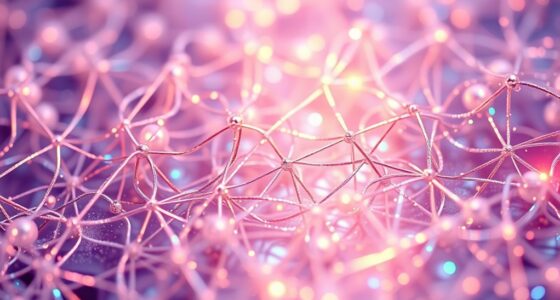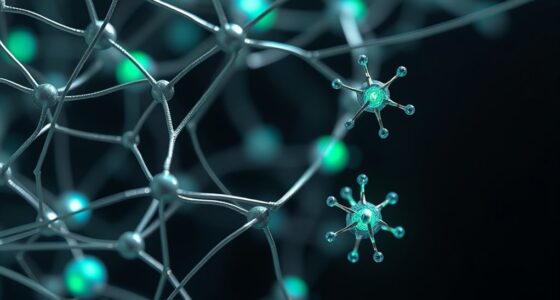Quantum mechanics is essential for nanomachines, as it controls electron behavior, energy transfer, and phenomena like superposition and entanglement that enable their unique functions. These quantum effects increase sensitivity and efficiency, allowing nanodevices to perform tasks impossible at larger scales. Tunneling and coherence enable faster energy transfer and precise control. You’ll discover how harnessing these quantum principles shapes the future of nanoscale technology and its promising applications.
Key Takeaways
- Quantum effects like superposition and entanglement enable nanomachines to perform complex functions beyond classical limits.
- Quantum tunneling allows particles to bypass energy barriers, enhancing energy transfer and reaction efficiency.
- Precise manipulation of quantum states controls nanomachine operations and facilitates secure quantum communication.
- Maintaining quantum coherence is essential for device stability, performance, and minimizing energy losses.
- Quantum mechanics enables the development of ultra-sensitive sensors and integrated quantum computing within nanodevices.
Quantum Phenomena in Nanoscale Devices
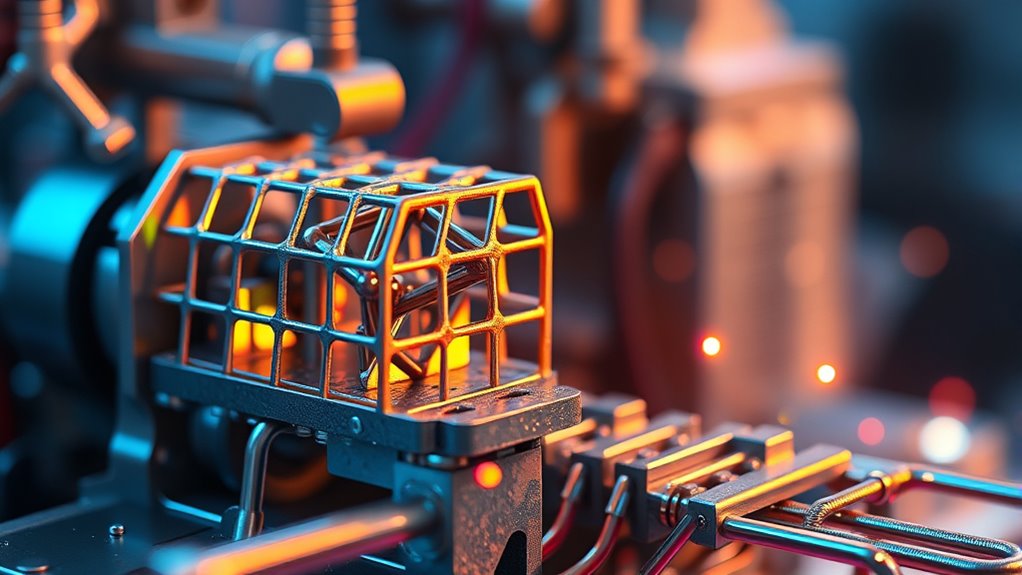
Quantum phenomena play a crucial role in nanoscale devices because their small size amplifies effects that are negligible at larger scales. When you work at this tiny scale, quantum effects like superposition and entanglement become significant, influencing how devices behave. For example, electrons no longer follow classical paths; instead, they exist in multiple states simultaneously, affecting conductivity and energy transfer. This means your nanoscale components can perform functions impossible at larger sizes. Recognizing these effects helps you design more efficient sensors, transistors, and other nanodevices. Quantum behavior also leads to increased sensitivity, allowing your devices to detect minute changes in their environment. By leveraging these phenomena, you can create innovative technologies that push the boundaries of what’s possible in nanoscience. Quantum coherence is a key principle that further enhances the potential of nanodevices by maintaining quantum states over extended periods.
Quantum Tunneling and Its Impact on Nanomachines
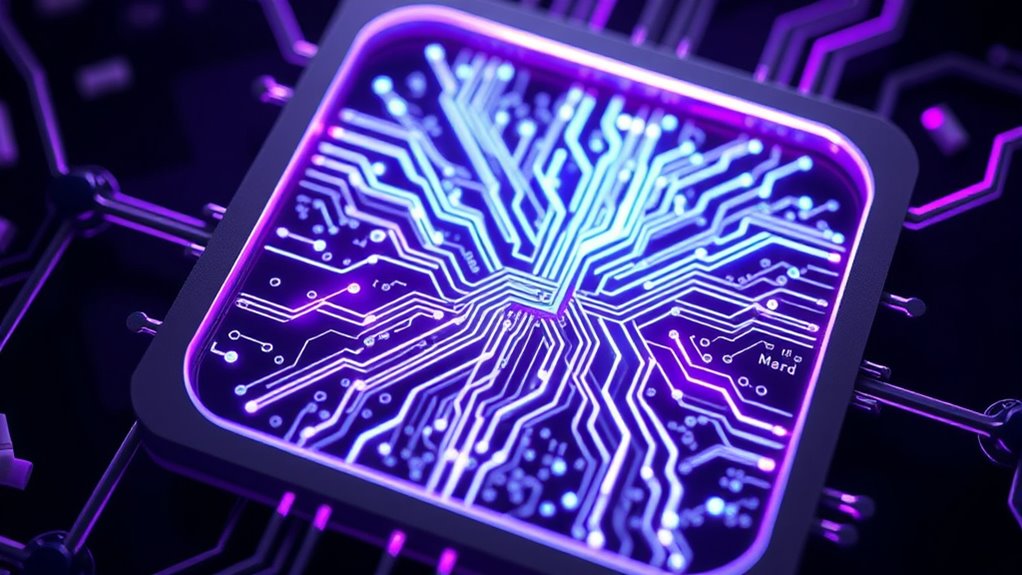
Quantum tunneling plays a vital role in nanomachine performance by affecting tunneling efficiency and energy barrier dynamics. As you optimize designs, understanding how to enhance tunneling can lead to faster, more reliable devices. Considering these factors helps you develop nanomachines that better harness quantum effects for practical applications. Additionally, ongoing research into AI security vulnerabilities can inform the development of more secure and resilient nanotechnologies.
Tunneling Efficiency Enhancement
Enhancing tunneling efficiency is essential for improving the performance of nanomachines, especially since quantum tunneling allows particles to pass through energy barriers that would be insurmountable classically. To boost efficiency, you can manipulate the properties of the tunneling barrier, such as reducing its width or height, which directly increases tunneling probability. Material engineering plays a key role, enabling you to create structures with tailored electronic properties that favor tunneling. Applying external electric fields can also lower barriers temporarily, improving particle passage. Additionally, optimizing the environment, like temperature control or using specific substrates, can minimize decoherence and energy loss. These strategies help you maximize tunneling rates, making nanomachines faster, more efficient, and better suited for complex tasks at the quantum level. Understanding quantum tunneling mechanisms can further inform how to optimize these enhancements for specific applications.
Energy Barrier Dynamics
Have you ever wondered how particles can pass through energy barriers that seem insurmountable? Quantum tunneling makes this possible, dramatically influencing nanomachines behavior. In nanomachines, energy barrier dynamics determine how efficiently particles move and interact. Quantum effects allow particles to temporarily exist on the other side of a barrier, bypassing classical limitations. This impacts processes like energy transfer, chemical reactions, and information processing.
- Tunneling probability depends on barrier width and height
- Fluctuations in energy can enhance tunneling rates
- Barrier properties directly affect particle transmission efficiency
- Quantum effects play a crucial role in shaping the efficiency and capabilities of nanomachines.
Design Implications
Understanding how quantum tunneling influences nanomachine design is essential for optimizing their performance. Tunneling allows particles to pass through energy barriers that classical physics would block, which can lead to unintended energy losses or malfunctions. To counteract this, you need to carefully engineer barriers, adjusting their width and height to control tunneling rates. Materials choices also play a key role in minimizing undesired tunneling effects. Additionally, you might leverage tunneling intentionally for specific functions, such as rapid electron transfer in sensors. Recognizing when tunneling enhances or hinders your nanomachine’s operation helps you develop more reliable, efficient devices. Ultimately, incorporating quantum tunneling considerations into your design process ensures your nanomachines function as intended at the quantum level, improving their overall robustness and capability. Material selection is crucial in controlling tunneling effects and enhancing device performance.
Superposition and Coherence in Nanoscale Operations

How do quantum superposition and coherence enable nanoscale devices to perform tasks beyond classical limits? They allow particles to exist in multiple states simultaneously, increasing processing power and efficiency. Coherence maintains the phase relationships between these states, ensuring precise control over quantum behavior. This synergy enables nanoscale machines to execute complex functions that classical systems can’t manage. Additionally, understanding quantum for sale helps in optimizing device performance and scalability.
Entanglement and Quantum Communication Within Nanostructures
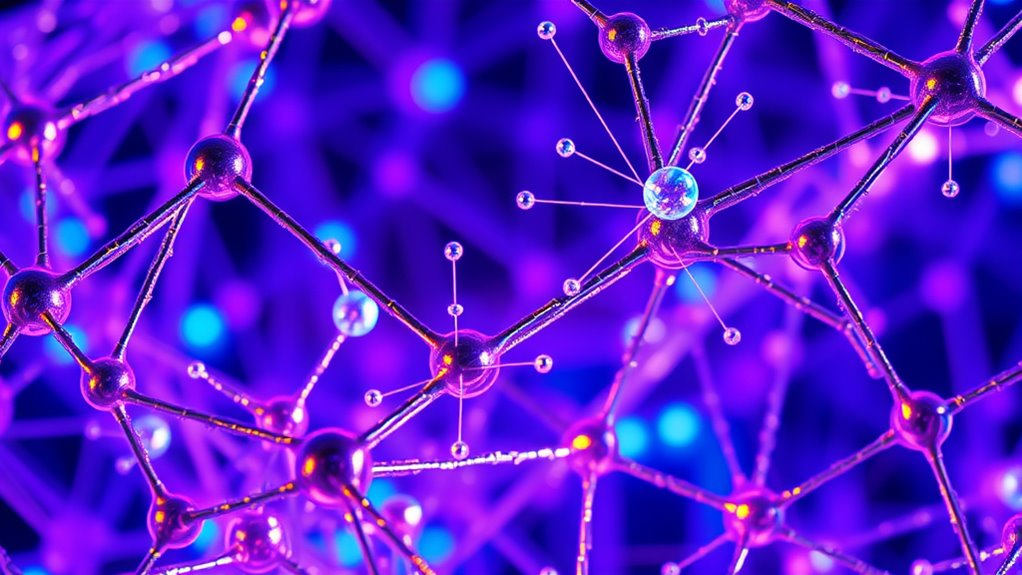
You can harness quantum correlations within nanostructures to enable secure and efficient communication. These entangled states allow for faster information transfer with high fidelity, even at tiny scales. Understanding these processes is key to advancing quantum networks in nanomachines. Additionally, mastering quantum entanglement can lead to breakthroughs in scalable quantum computing and secure data transfer across nanostructures.
Quantum Correlations in Nanostructures
Have you ever wondered how quantum correlations, especially entanglement, can be harnessed within nanostructures? These correlations enable unique interactions that can enhance nanomachine performance. You can leverage entanglement to improve energy transfer, increase measurement precision, or enable secure quantum communication over tiny distances. Understanding how to create, control, and maintain these correlations is vital. AI security is also crucial for safeguarding the delicate quantum information processed within these systems.
- Establishing entanglement between nanostructures
- Maintaining coherence amid environmental noise
- Using quantum correlations for information transfer
Communication Speed and Fidelity
Achieving rapid and reliable quantum communication within nanostructures hinges on the efficient generation and preservation of entanglement. You need to create entangled states quickly and maintain their coherence despite environmental disturbances. Advanced techniques, like dynamical decoupling or error correction, help protect entanglement from decoherence, ensuring high fidelity. Faster communication requires optimizing coupling strengths and minimizing latency between qubits. Quantum repeaters and entanglement swapping can extend communication distances within nanomachines, boosting speed without sacrificing accuracy. Ultimately, balancing speed and fidelity depends on precise control over quantum states and isolating them from noise. With ongoing innovations, you can push the limits of quantum data transfer, enabling nanomachines to operate more efficiently and reliably at the quantum level. Additionally, understanding the role of contrast ratio and other image quality factors in optical systems can inspire better control mechanisms within quantum devices.
Designing Nanomachines With Quantum Control Techniques

Designing nanomachines with quantum control techniques involves harnessing the principles of quantum mechanics to manipulate matter at the nanoscale with unprecedented precision. You can precisely steer quantum states to achieve desired functions, such as targeted drug delivery or molecular assembly. Quantum control employs methods like laser pulses, electromagnetic fields, and feedback loops to influence quantum behavior effectively. This approach allows you to:
- Optimize quantum coherence for stability
- Minimize decoherence and error rates
- Achieve fine-tuned control over quantum states
Quantum coherence plays a vital role in maintaining the stability of these nanoscale systems.
Quantum Effects in Energy Transfer and Conversion

Quantum effects play a vital role in energy transfer and conversion at the nanoscale, where classical models often fall short. You’ll find that phenomena like quantum tunneling enable particles to pass through energy barriers that would be insurmountable classically, increasing efficiency in nanomachines. Coherence allows energy to move coherently between molecules, reducing losses and enhancing transfer speed. Additionally, quantum superposition can facilitate simultaneous pathways, optimizing energy flow. In photosynthetic systems, for example, quantum coherence helps transfer excitation energy with minimal loss. These quantum effects enable more efficient energy conversion processes, essential for developing advanced nanodevices. Understanding and harnessing these phenomena can revolutionize energy management at the nanoscale, leading to breakthroughs in nanotechnology applications where classical physics alone cannot explain or optimize energy transfer mechanisms.
Challenges in Harnessing Quantum Mechanics for Nanotechnology
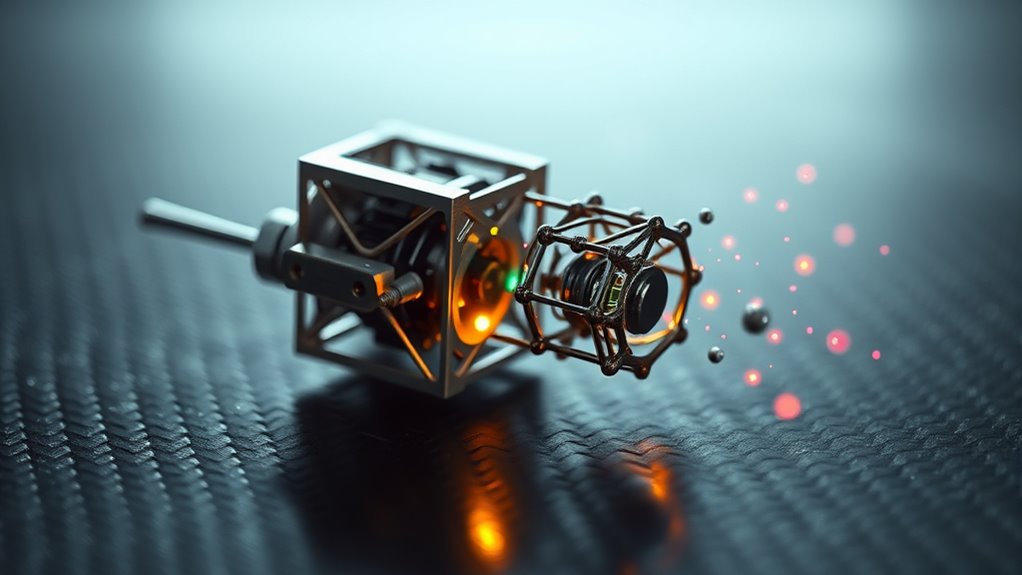
While quantum effects can particularly boost energy transfer efficiency at the nanoscale, harnessing these phenomena in practical nanotechnology faces numerous obstacles. Quantum behaviors are highly sensitive to environmental disturbances, making stability a major challenge. Controlling and maintaining coherence over time requires advanced isolation techniques, which are difficult to implement at scale. Additionally, integrating quantum components with existing technologies demands precise fabrication methods that are still under development.
Quantum benefits at nanoscale face stability, control, and integration challenges.
- Environmental noise causes decoherence, disrupting quantum states
- Achieving precise control of quantum phenomena remains technically demanding
- Scaling up quantum nanodevices while maintaining stability is complex
Future Perspectives and Innovations Driven by Quantum Physics

Advances in quantum physics are opening exciting pathways for nanotechnology, promising innovations that could revolutionize various industries. You’ll see the development of ultra-efficient quantum sensors, enabling precise measurements at the atomic level, transforming healthcare, environmental monitoring, and manufacturing. Quantum computing integrated with nanomachines can dramatically boost processing speeds and data security, opening new horizons for complex problem-solving. Additionally, quantum entanglement could lead to breakthroughs in communication systems, making data transfer faster and more secure. As researchers continue exploring quantum phenomena, you can expect the emergence of smarter, more adaptable nanodevices that leverage quantum coherence and superposition. These innovations will not only enhance existing technologies but also inspire entirely new applications, fundamentally transforming how we approach medicine, energy, and information processing in the near future.
Frequently Asked Questions
How Does Quantum Decoherence Affect Nanomachine Stability?
Quantum decoherence can destabilize nanomachines by disrupting their delicate quantum states. When environmental interactions cause decoherence, the coherence essential for precise control diminishes, leading to errors or malfunction. As you operate or design nanomachines, you must account for decoherence effects, implementing strategies like isolation or error correction. This helps maintain stability, ensuring your nanomachines perform reliably despite the challenges posed by quantum decoherence.
Can Quantum Entanglement Improve Nanomachine Communication Efficiency?
You might be surprised, but quantum entanglement can actually boost nanomachine communication efficiency by enabling instant data transfer between particles. Studies show entangled particles maintain correlations over long distances, reducing delays and errors. This means you could see faster, more reliable nanomachine networks in the future. By harnessing entanglement, you can potentially revolutionize nanoscale communication, making it nearly instantaneous and highly secure, opening new frontiers in technology.
What Materials Are Best Suited for Quantum Nanomachines?
You should consider materials like graphene, carbon nanotubes, and diamond-like carbon for quantum nanomachines. These materials offer exceptional electrical conductivity, mechanical strength, and quantum coherence, making them ideal for maintaining quantum states. Their stability at nanoscale dimensions allows you to build efficient, durable devices capable of precise quantum control. By choosing these materials, you guarantee your nanomachines perform reliably in advanced quantum applications.
Are Quantum Effects Significant at Room Temperature in Nanodevices?
Quantum quirks quickly quiet at room temperature, making effects less significant in nanodevices. You’ll find that thermal energy often overwhelms quantum phenomena, causing decoherence and diminishing quantum advantages. While some specialized materials can maintain quantum states at higher temperatures, generally, you need ultra-cold conditions to observe and utilize quantum effects effectively. So, in everyday environments, quantum effects tend to be subdued, and classical physics dominates your nanodevice operations.
How Close Are We to Commercial Quantum Nanomachines?
You’re still a few years away from seeing fully commercial quantum nanomachines. Researchers have made progress in developing prototypes, but challenges like stability, scalability, and cost remain. Currently, most quantum nanodevices are in laboratory testing or limited applications. With ongoing advancements, expect to see more practical, market-ready quantum nanomachines within the next decade, transforming industries such as medicine, electronics, and materials science.
Conclusion
You now see how quantum mechanics acts as your secret weapon in nanomachines, turning tiny wonders into powerful tools. As you navigate this quantum domain, remember that even in an era of steampunk-inspired innovations, harnessing these phenomena can revolutionize energy, communication, and design. Embrace the challenge, and who knows? Maybe someday, your nanomachines will be as legendary as Da Vinci’s sketches—an extraordinary leap into the future.


